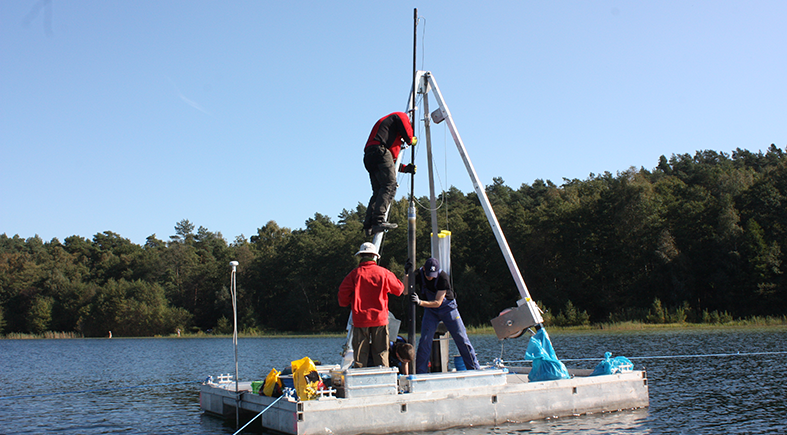27.06.2016: Over the past decades, the water level for lakes of the Northern German Lowland dropped in many places. This was often caused by human activities like the draining of soils for agriculture or settlements. A study of scientists from the GFZ German Research Centre for Geosciences now shows that there were much more drastic changes in lake levels occurring over the past thousands of years, especially before humans started to have an impact on the water cycle. Research at “Großer Fürstenseer See“ at Neustrelitz (Müritz National Park) shows ups and downs in lake level of about four meters in either direction over the past 10,000 years. To compare: Since the 1980s the lake level lowered for about 1.30 meters. “In only a few millenia the lake area dropped by half or was threefold increased compared to todays extent”, explains first author of the study Dr. Elisabeth Dietze from the GFZ. The study is published in the current edition of the scientific journal BOREAS.
For the study, scientists from the virtual German-Polish research Institute ICLEA investigated the lake taking samples from the sediment and using echo-sounding following a transect through the lake and compared the results with recent investigations of lake level changes. Their reconstructions of the lake level showed that a peak was reached about 5,000 years ago with a lake level of four meters above todays level. In contrast, about 6,400 to 9,700 years ago the lake level was about three to four meters lower than today.
A possible explanation may be a combination of climate change and changes in forest structure the scientists suggest. The early Holocene pine forests (the first forests after the ice age) had a high demand in water with a negative impact on groundwater recharge. In contrast subsequent deciduous forests contributed to groundwater recharge, e.g. by an increased trunk flow. This is also true for today, the GFZ hydrologists indicated. Because of a more humid middle and late Holocene the lake levels remained relatively high throughout the past 4,000 years. They were only impacted by humans since medieval times. Analyses of instrumental investigations from the region of the past 40 to 60 years indicate variations in climate as the main driving force: Precipitation deficits cause local lowering of groundwater tables. However, there are also significant correlations with forest structure, a study from 2012 by colleagues from the Leibniz-Centre for Agricultural Landscape Research (Müncheberg) showed. Implications for the future are that more severe variations in lake level than detected so far can be expected. These will however not only be forced by climate change but also by future forest structure in the national park.
„The new results show that changes in regional water cycle can be quite massive if one considers not only hundred but 10,000 years”, Ingo Heinrich says. He coordinates the regional observatory “TERrestrial ENvironmental Observatories – Northern German Lowland” (TERENO Nord-Ost). This platform was initiated to investigate local changes in water cycles and to better understand the impact of global change on regional scale.
Dietze, E., Słowiński,M., Zawiska, I., Veh, G., Brauer, A., 2016. Multiple drivers of Holocene lake level changes at a lowland lake in northeastern Germany. BOREAS. doi: 10.1111/bor.12190
-------------------









![[Translate to English:] Torsten Sachs in front of a climate station on a field](/fileadmin/_processed_/3/9/csm__TorstenSachs_bearbeitet_GS_4a1365ef84.jpeg)

![[Translate to English:] left image flood at the Ahrtal: image from above, several houses are flooded; left image:: Heidi Kreibich;](/fileadmin/_processed_/4/4/csm_Bild2_9af0130e9f.png)



![[Translate to English:] Start der Vega Rakete](/fileadmin/_processed_/6/4/csm_20231201-kachel_Vega-VV23-launch_ESA-CNES-Arianespace_706716b68c.jpeg)









![[Translate to English:] Poster exhibition at the Brandenburg Hydrogen Day at the GFZ, some participants in the foreground](/fileadmin/_processed_/6/5/csm_Erster_Brandenburgischer_Wasserstofftag_GFZ_402fcec95e.jpeg)
![[Translate to English:] Group picture of the participants](/fileadmin/_processed_/9/4/csm_20231108_CAWa-Workshop-Tashkent_Gruppenbild_99ea779d8a.jpeg)

![[Translate to English:] [Translate to English:] Hörsaal](/fileadmin/_processed_/e/6/csm_H%C3%B6rsal_e21ac645fb.jpeg)


![[Translate to English:] The Delegations in the Historic Library on the Telegrafenberg. In the back there are from left to right, the Dutch Ambassador for Germany, Ronald van Roeden, the Dutch Minister for Education, Culture and Science, Robbert Dijkgraaf and the scientific director of the GFZ, Susanne Buiter.](/fileadmin/_processed_/d/b/csm_Kachel-2_9eba4b4212.jpeg)

